| Shear
rock face cliffs and jagged peaks were the norm along the Da Ning
River making for some spectacular scenery. While there were no level
markers indicating how high the DA Ning will rise when the dam is
completed, you could imagine that much of this scenery, including
the small rocky beaches where we stopped, would be flooded forever.
The landscape of these Lesser Three Gorges will forever change and,
I'm afraid, it won't be an improvement. The dramatic scenes along
the DA Ning will forever be tamed by the rising waters of the dam.
What a shame! |
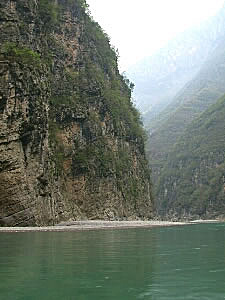 Shear
rock cliffs
Shear
rock cliffs |
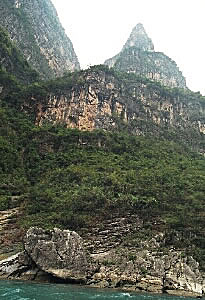 Jagged
peaks
Jagged
peaks |
|
|
|
|
|
|
|
|
|
|
|
|
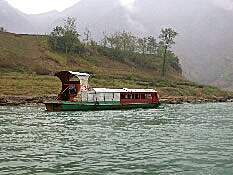 Converted
tourist sampan
Converted
tourist sampan
now someone's home |
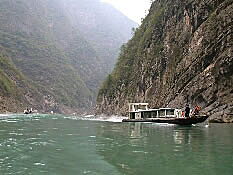 The
river was a flurry of activity
The
river was a flurry of activity
with many boats ferrying tourists |
 Anne
sitting in the less-crowded
Anne
sitting in the less-crowded
rear of the sampan |
|
|
|
|
|
|
|
|
|
|
|
|
 Goats
grazing at the river's edge
Goats
grazing at the river's edge |
All
along the river's shore there was much to look at. When the scenery
wasn't spectacular with its shear vertical cliffs and jagged peaks,
we enjoyed much simpler fare ... like the goats grazing (left) on
the shore. But one of the more enjoyable sights along the river were
the wild monkeys. We've all seen monkeys before in zoos so it was
a real treat to observe them in the wild. |
|
|
|
|
|
|
|
|
|
|
|
|
 Wild
monkeys in the trees (photo by John)
Wild
monkeys in the trees (photo by John) |
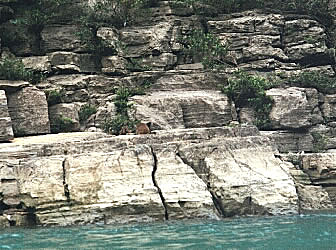 Monkeys
sitting on the rocks
Monkeys
sitting on the rocks |
|
|
|
|
|
|
|
|
|
|
|
|
| We
all surmised that the tour operators regularly feed them along this
particular stretch of the river. It's the only place we saw them and
there were many other similar areas but no monkeys. Who cares? We
definitely enjoyed seeing them. If only the weather had been sunnier
and the boat going a bit slower the pictures would have been better. |
|
|
|
|
|
|
|
|
|
|
|
|
|
|
|
The
sampan crew consisted of the captain who steered the boat and three
men who stayed on the bow. It was their job to assist the boat over
the shallow areas when the rush of the water was the greatest. They
used bamboo poles to push the boat forward. There were several times
when they worked hard to get us over the shallow parts. I should mention
that the time of the year we were there was approaching the Yangtze's
lowest water level of the year. We were told the cruise ships only
had two weeks left until the end of the season because the water level
would be to low to continue until the winter runoff begins in the
Spring. |
|
|
|
|
|
|
|
|
|
|
|
|
| On
our way down river the crew extended a large wooden pole from the
bow of the sampan. I'm not sure the purpose of the pole and can only
guess it might be used to insure that the sampan didn't run into another
boat in front of it. Looking at it you'll see that it definitely appears
to be dangerous. If a side collision between two boats occurred the
pole would definitely have extended through the passenger cabin. One
crewman also stood on the bow holding a white flag to verify to meeting
boats that safe passage was possible. |
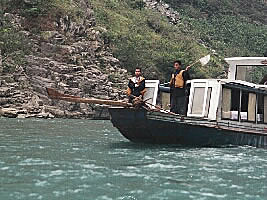
The
extended pole and white flag
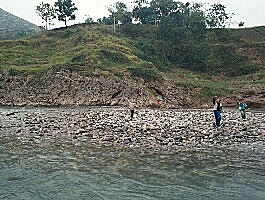
Children
wave from shore
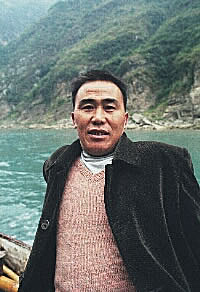
An
friendly crew member
|
|
|
|
|
|
|
|
|
|
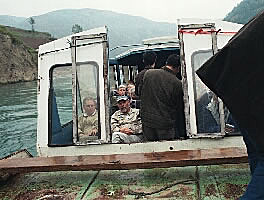 A
view from the front of the sampan
A
view from the front of the sampan
showing the group getting the
sales pitch from our local tour guide |
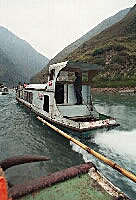 Close
proximity of
Close
proximity of
sampans on the
return journey |
|
|
|
|
|
|
|
|
|
|
On
our way downstream I ventured out onto the bow of the ship. The
crew greeted me and provided a pillow for me to sit on and take
pictures. One of the crew members (picture right) tried hard to
communicate with me. Unfortunately his English and my Chinese were
nonexistent. Instead of using words he began to use gestures. He
obviously liked my beard and tried to tell me that the only way
he could, through his hand gestures and expressions. Later, toward
the end of the cruise, he sat next to me and again tried to communicate
his age. I'll never forget the last thing he said to me. He tried
to communicate it through hand gestures and words, but I couldn't
understand him. I asked Mei, our tour escort to translate for me.
He was telling me that we were now good friends, the Chinese and
the Americans, him and I. I thought that was very nice of him to
even think of communicating something like that. And I found it
typical of the Chinese that we met during our trip. They were all
very friendly toward us.
As
we left the sampan I couldn't help but wonder how his livelihood
might be affected by the flooding. It's possible that it could disappear.
|
|
|
|
|
|
|
|
|
|
|
|
|
| Before
we knew it our excursion up the DA Ning River was over and we were
back aboard the Princess Elaine heading upriver toward Chongqing. |
|
|
|
|
|
|
|
|
|
|
|
|
|
|
|
Sailing
on the Yangtze and looking at the many cities and towns along the
river, like above, knowing
that they will, for the most part, disappear in the next year you
can't begin to imagine what the
Chinese people are going through. Millions are being resettled to
higher, less fertile ground. Many
are forced out of their homes that their families have lived in
for centuries. All for the sake of
progress, modernization, power and flood control. The one good thing
about damming the Yangtze
is the flood control it will provide. It will save hundreds of thousands
of lives in the coming years.
|
|
|
|
|
|
|
|
|
|
|
|
|
Now,
back on the Yangtze, we were headed into the last and final gorge,
the Wu Gorge. The Qutang Gorge was the smallest of the three gorges
and the narrowest. Join us on the next page for pictures from the
Wu Gorge ... |
|
|

